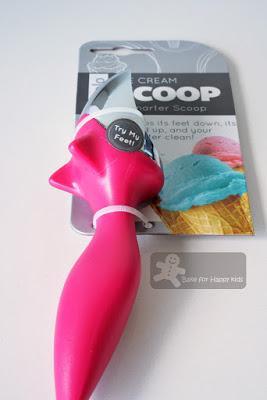In order to know if a croissant is good enough, the same article suggests that every croissant can be rated in four areas: its crust, interior, flavour, and overall enjoyment.
1) The Crust
The ideal crust should be distinct from the softer interior. Like what Bouchon Bakery has described their croissants, it should shatter and flake off when bitten or torn. It should be extremely crisp, but not crunchy or tough. Each layer of flaky pastry should virtually melt on the tongue, but not leaving grease on your hands and plates. It should be evenly golden brown.
2) The Interior
It should be feather-light with many distinct stretchy layers and can separate from each layer easily when the croissants have been pulled apart. It should be tender and moist but not gummy or doughy.
3) The Flavour
Being mainly made with butter, an ideal croissant should be the most ideal baked goods showing off the best quality of butter! It should be intensely buttery with a natural dairy sweetness. It should not be too sweet or too salty.
4) Overall Enjoyment
Obviously, the most ideal croissants are actually those that we can enjoy them to the fullest even on their own. Do you agree?
Where can I find these good croissants? The Wall Street Journal and Paris by Mouth has listed top spots to look for really good croissants in Paris. And, Serious Eats has listed top fifteen bakeries that sells the best croissants in New York. Only Paris and New York???!!! Goodness me!!! As I Googled further, I noticed that we are lucky these days that we don't have to travel to New York or France to enjoy the finest croissants as The Urban List has listed six bakeries that sells the best croissants in Melbourne.
Then I question myself... Is it possible to bake a good croissant? I have seen croissant recipes everywhere when I search for "best croissant recipe" at Google, I find recipes at here, here, here, here and more more more... Despite the fact that most of these recipes are well reviewed, I choose not to use any of them! Huh!!!??? Call me ya ya (meaning arrogant in Singlish) or ambitious! ... because I like to bake a recipe from the bakery in the top list that sells the best croissants and here I have chosen the recipe from Bouchon Bakery which is listed as the eighth best croissant bakery in New York.
Why don't I not use the recipes from other best croissants bakeries? Simply because I have the book, Bouchon Bakery by Thomas Keller and Sebastien Rouxel... LOL! I'm so lame!!!
Now, proudly presenting my homemade "Bouchon Bakery" croissants... that I have baked along with Joyce from Kitchen Flavours and Lena from Frozen wings...
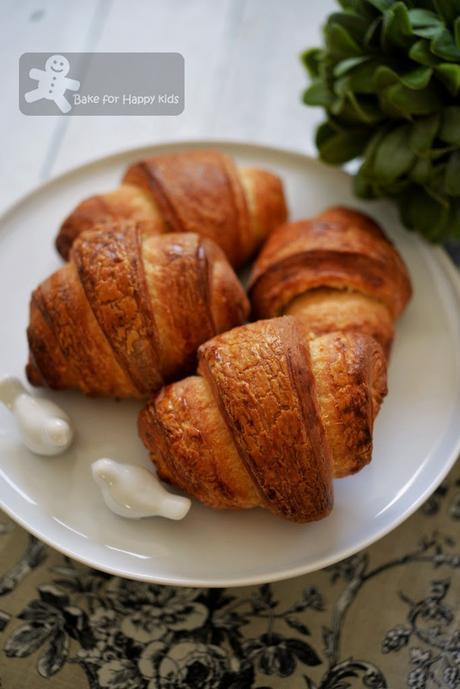
Homemade Crossiant from Scratch ( Recipe by Bouchon Bakery)
I know making croissant from scratch is not easy especially the shaping bit. My biggest nightmare of making croissants is when the butter start to melt and ooze out the pastry... ewww! The cleaning of the messy greasy butter all over my kitchen top... Double ewww!Plus, I need measurements to get the shape of the croissants right and so I'm using this Tovolo pastry mat to get my task done more effectively.

This Tovolo pastry mat is given to me by Tovolo Australia (Donaldson).
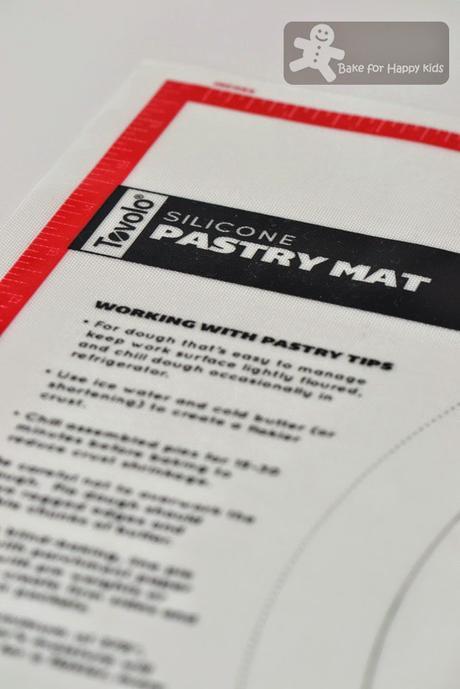
It is a large silicon mat and is non slip and fabulous to use for pastry rolling.
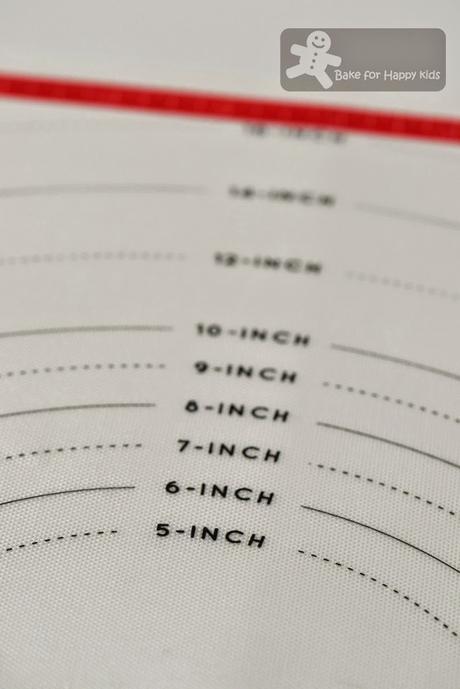
Like most pastry mat, this mat has circular markings to help us to roll round pastries into their right sizes.
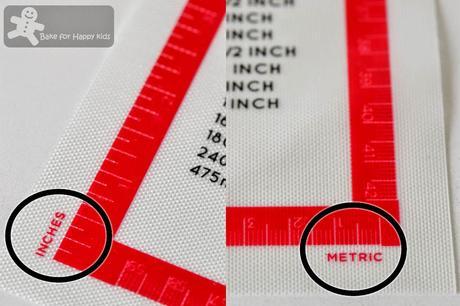
Confused with inches? Or lost in metric system? Not to worry!!!
Unlike some pastry mats, this Tovolo mat has 4 sides of measuring scales.
2 sides are in inches and 2 sides are in centimeters.
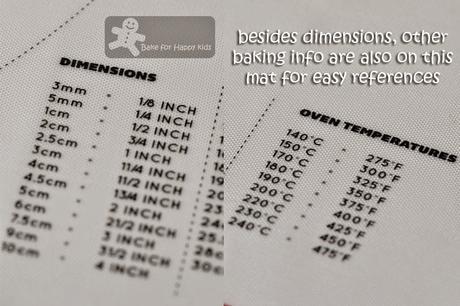
It has baking info like volume conversion from ml to tsp / cups, weight conversion from gram to oz and also working with pastry tips.
Having this mat with me, I'm feeling more confident now to bake good croissants... Having said that, I like strengthen my croissant baking further with a little background knowledge too.What defines a croissant? It is a buttery, flaky pastry named for its well-known crescent shape.Flaky pastry? Is the technique of making puff pastry the same as making croissants? Yes and No. Yes because a croissant dough is layered with butter, rolled and folded several times in succession and this process results texture and layers that are very similar to a puff pastry. No because croissant dough is yeasted and has to be handled a little different from puff pastry. As the only leavening from the puff dough comes from the layering, the Bouchon Bakery recipe mentions that the puff pastry requires at least five turns to get many hundreds of layers. As the croissant dough is also leavened by the yeast, the Bouchon Bakery recipe gives the croissant dough only three turns. Not one less or more... Only three.Now, I'm ready...
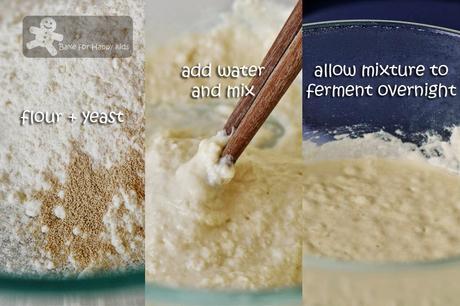
On the day before, I started by making the poolish.
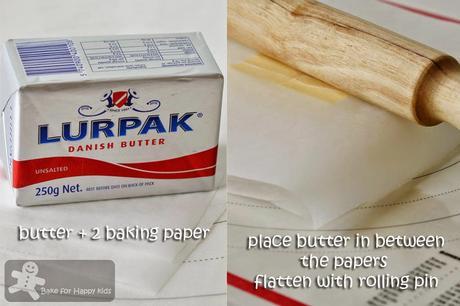
Then, I prepared the butter block and refrigerated it overnight.
Next, the shaping bit... I have to admit that these steps are very intimidating!!! I have came across very illustrative and professional photos showing the shaping of croissants in the book, The French Baker by Jean Michel Raynaud.Now, see this! This was done by the professional.
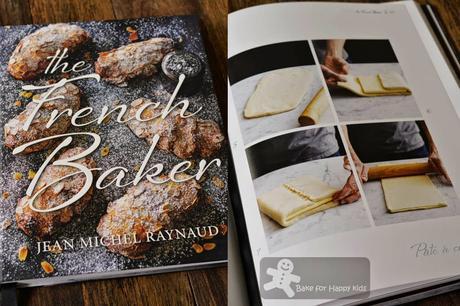
This is how Jean Michel Raynaud enclosed butter into his croissant pastry.
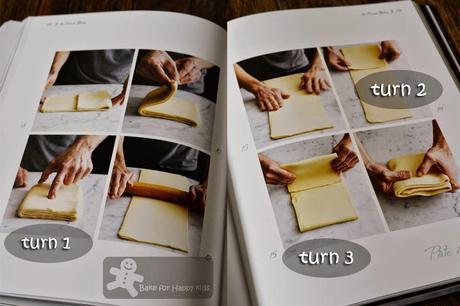
This is how Jean Michel Raynaud rolled and folded the pastry. VERY NEAT!!!
Then, see this! This was done by the amateur me...
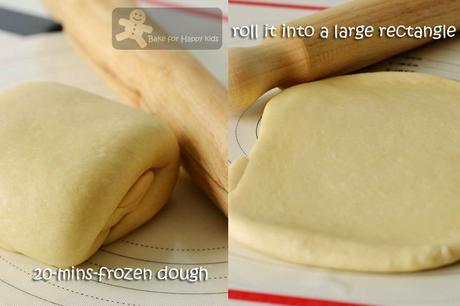
On the day of the bake, I combined the poolish and dough ingredients to knead and prove this dough.
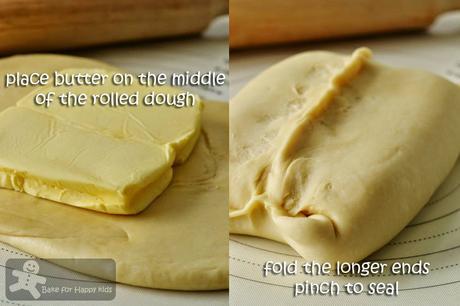
Here's the butter... the kiasu (meaning afraid to lose in Singlish) me refused to leave the butter exposed at both ends and pinch everything to seal the pastry :p

This is turn one!
It is so hard to roll the dough into an angular rectangle!
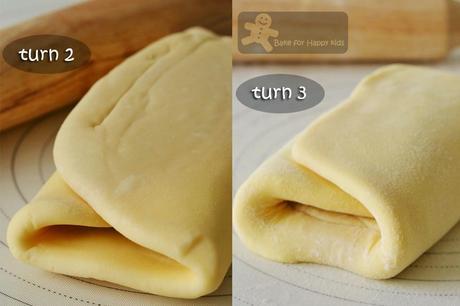
Freeze the pastry for 20 mins before each rolling and turn.
I survived!!! ... but mine is a far cry from the professionally made ones :p
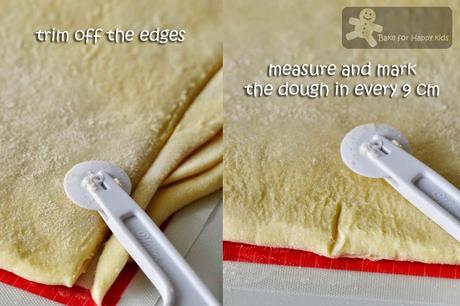
With the help of the measuring sides of the mat, I'm cutting the pastry...

... into these 7 triangles
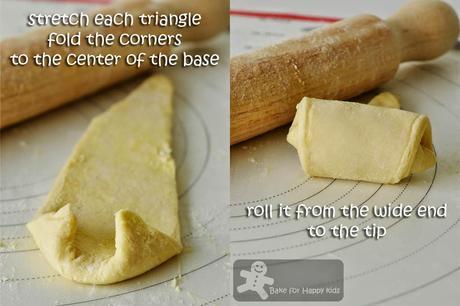
This is how I shape each croissant.
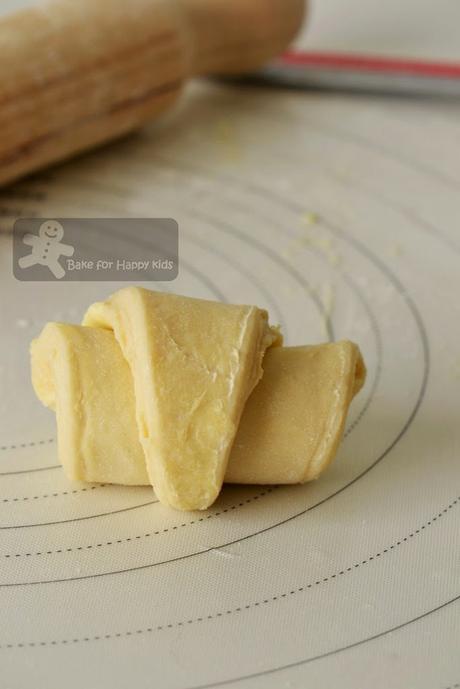
Ta-dah!
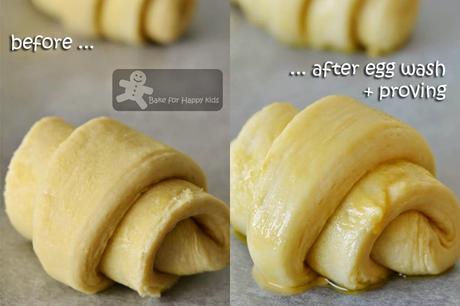
This proving step takes about 2 hours.
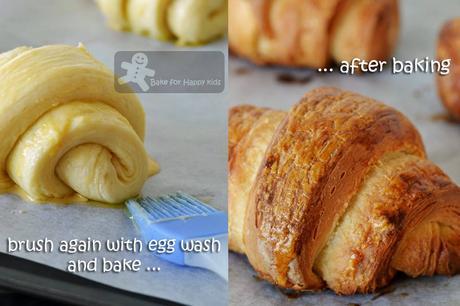
Smell yummy!
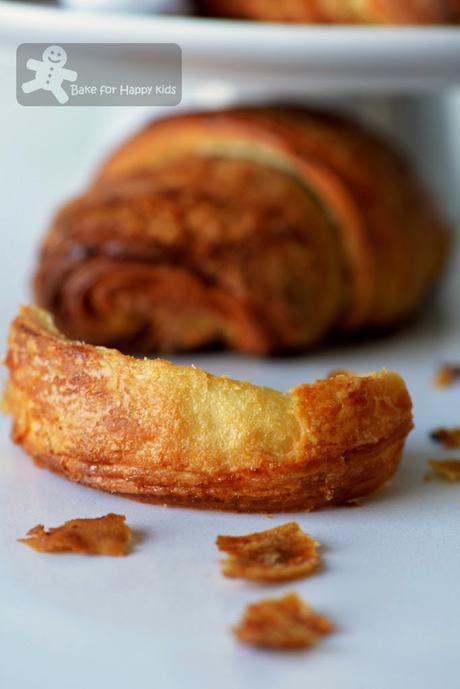
Yay!!! ... that it shatters!
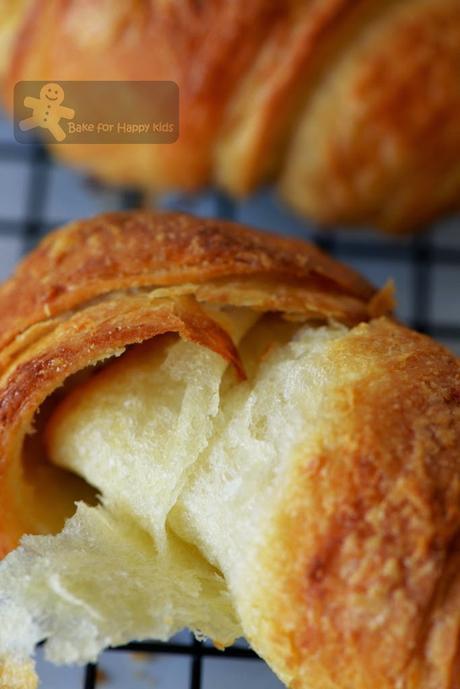
Double yay!!!... that the layers are thin and brittle!
Is this a good croissant? I would think so!
YAY!!! ... that I have survived from this bake!
Here's the recipe that I have mostly adapted from the book, Bouchon Bakery by Thomas Keller and Sebastien Rouxel or here, rounding up or down the odd measurements that Keller prefers.
I have made 7 croissants with half of the ingredients listed in the original recipe and will indicate the amount and measurements or any modifications that I used in blueMakes 16 croissants
For the poolish:
100g all purpose flour - I used 50g bread flour.0.1g a pinch instant yeast
100g water at 24°C - I used 60g with a little extra as the mixture looks dry.
For the butter block:
330g unsalted butter - I used 150g.For the dough:
250g all purpose flour - I used 250g bread flour.75g caster sugar - I used 35g.
10g instant yeast - I used 1 1/4 tsp.
3g malt powder - I didn't add this.
200g water at 24°C - I used 120g with a little extra as the dough looks dry.
100g unsalted butter - I used 50g.
15g salt - I used 7g.
For the egg wash:
eggs, beaten and strained through a sieve- I used 1 egg yolk + 2 tbsp milk, roughly beaten together.
For the poolish:Combine the flour and yeast in a medium bowl and mix well with your fingers or a pair of chopsticks. Pour in the water and mix until thoroughly combined; the mixture should have the consistency of pancake batter.
Cover the bowl loosely with plastic wrap and let it sit at room temperature for 12 to 15 hrs. The mixture will be bubbly, but the best indication that it is ready are lines on the surface that look like cracks that are beginning to fall in at the center, as the yeast exhausts its food supply.
For the butter block:
Place a piece of baking paper on the work surface. Just in case of any mess, I have placed Tovolo pastry mat on my work surface for this job. Center the butter on the paper. Top with a second piece of baking paper and pound the top of the butter from left to right with a rolling pin to flatten it. Continue to flatten the butter until you have a 6 3/4 x 7 1/2 inches (mine is 3 x 3 1/2 inch or 8 x 9 cm) rectangle. Wrap tightly in the baking paper and refrigerate until firm or preferably overnight.For the dough:
Spray a large bowl with nonstick spray. Combine the flour, sugar, malt powder (I didn't add this and added salt in this step) and yeast in the bowl of a stand mixer fitted with the dough hook and give it a quick mix on the lowest setting to distribute all of the ingredients evenly.Pour about half the water around the edges of the bowl of poolish to help release the poolish, then add the contents of the bowl along with the water (reserving 50g) into the mixer. Add the butter and mix on low speed for 2 mins to moisten the dry ingredients. Scrape down the sides and bottom of the bowl to make sure all the flour has been incorporated. Sprinkle the salt over the top and mix on low speed for 2 mins to dissolve the salt - I have added the salt earlier. If the mixture looks dry, add the reserved water in very small amounts as needed. Continue to mix on low speed for 20 mins.
Run a bowl scraper around the sides and bottom of the bowl to release the dough and turn it out onto the work surface. To knead the dough further, stretch the left side of the dough outward and fold it over the center of the dough, then stretch and fold the right side over to the opposite side, as if you were folding a letter. Repeat the process, working from the bottom and then the top. Turn the dough over, lift it up with a bench scraper, and place it seam side down in the prepared bowl. Cover the bowl with plastic wrap or a dish towel and let sit at room temperature for 1 hr.
Note: Instead of using an electric mixer and kneading by hand, I have used my breadmaker with dough setting to mix, knead and prove the croissants dough for 1 1/2 hr.
To shape the dough:
To ease my cleaning job, I placed Tovolo pastry mat on my work surface for all of these following shaping job. Uncover the dough, run the bowl scraper around the sides and bottom of the bowl to release the dough, and turn it out onto a lightly floured work surface, disturbing the structure as little as possible. Gently but firmly pat or roll the dough into a rectangle about 10 x 7 1/2 inches (mine is 4 3/4 x 3 1/2 inches or 12 x 9 cm), pressing any large gas bubbles to the edges and then out of the dough. Line a baking tray with baking paper and transfer dough onto the lined baking tray. Cover with plastic wrap and freeze for 20 mins.To encase the butter block:
Lightly flour the work surface and a heavy rolling pin. Turn the dough out onto the work surface and lightly dust the top with flour. Roll the dough outward from the center, rotating it frequently and flipping it from time to time, adding just enough flour to the work surface, dough, and the rolling pin to prevent sticking, until you have a 16 x 7 1/2 x 1/2 inches (Mine is 7 3/4 x 3 1/2 inch or 20 x 9 cm) rectangle. Lay the block of butter across the center of the dough. Stretch and fold over the two longer sides so they meet in the center and pinch together to seal.For turn one:
Using the rolling pin, press down firmly on the dough across the seam from one side to the other to expand the dough. Turn the dough so a short end faces you. Roll to expand the length of the dough, flipping, fluffing, and turning the dough over and adding flour only as needed, until you have a rectangle approximately 22 x 9 x 3/8 inch (mine is 8 1/2 x 10 1/2 x 3/8 (thickness) inches or 22 x 27 x 1 (thickness) cm).Fold the bottom third of the dough up as if you were folding a letter. Fold the top third down to cover the bottom third. Turn the block 90 degrees so the dough resembles a book, with the opening right. You will continue this pattern with each roll, and keeping the opening on the right will help you remember how to position the dough.You have completed your first turn; gently press a finger into a corner to mark it. Return the dough onto the lined tray, cover with plastic wrap, and freeze for 20 mins or until the dough has stiffened but is not hard.
For turn two:
Lightly dust the pastry mat on the work surface with flour. Place the dough on the work surface with the opening on the right. It is important to work with the dough as quickly as possible, but not at the risk of the butter. Pressing on the dough will warm the butter; if it is too cold, it will shatter rather than spread as you roll it. Expand the dough by pressing down firmly with the rolling pin, working up the length of the dough. If the dough cracks at all along the edges, stop and let it warm room slightly at room temperature. Then roll out the dough as you did before to a 22 x 9 x 3/8 inches (mine is 8 1/2 x 10 1/2 x 3/8 (thickness) inches or 22 x 27 x 1 (thickness) cm) rectangle and repeat the folding. Turn the block 90 degrees, so the opening is on the right. You have completed the second turn: gently press 2 fingers into a corner to mark the dough. Return the dough onto the lined tray, cover with plastic wrap, and freeze for 20 mins, or until the dough has stiffened but is not hard.For turn three:
Repeat all of the steps for turn two and mark the dough with 3 fingerprints.To finish:
Line two baking trays with baking paper. Lightly flour the pastry mat on the work surface. Roll the dough on the work surface with the opening on the right. It is especially critical at this stage that the dough remain cold; freeze as needed.Roll the dough out to 24 x 9 inches. Cut the dough crosswise in half making two 12 x 9 inches rectangle. Stack them with a piece of baking paper between them and cover with plastic wrap and freeze for 20 mins. I didn't have to do this step because I'm using half of the recipe.
Remove one piece of dough from the freezer and position it on the work surface with a short end toward you: transfer the second piece of dough to the refrigerator. Roll dough to a rectangle about 19 x 9 inches (or 47 x 22 cm). Turn the dough so a long side is facing you and trim it to 18 inches long. Trim the remaining sides only as needed for straight edges.Starting at either the left or right side, measure 3 3/4 inches or 9 cm along the bottom edge of the dough and cut from this point to the top left - hand corner of the dough, making a triangle. For the second triangle, measure 3 3/4 inches or 9 cm along the top of the dough and cut from this point straight down. Continue cutting, alternating between the top and bottom of the dough, to make 8 triangles - I got 7 only.
Hold one triangle up by the base with one hand and, using your fingertips, gently pull the dough until it is stretched to about 12 inches or 30cm.
Put the dough on the work surface, with the base of the triangle close to you. Fold over the corners to the center of the base and roll the dough up from the wide end to the tip. Put on a prepared baking trays with the tail down. Press down slightly, flattening the croissant just enough so that it will not roll on the pan. Repeat with the remaining triangles of dough, spacing them evenly on the baking tray.
Remove the second piece of dough from the refrigerator and if necessary, let sit at room temperature until warmed enough to roll, then repeat to make 8 more croissants. I didn't have to do this step because I'm using half of the recipe.
Brush the croissants with the egg wash. Cover the trays with plastic tubs or cardboard boxes and let proof for about 2 hrs. When the dough is delicately pressed with a finger, the impression should remain.
Position the racks in the upper and lower thirds of the oven and preheat the oven to 350°F or 180°C or 170°C fan forced.
Brush the croissants again with egg wash. Bake for 30-40 mins in a standard oven, rotating the pans once halfway through baking and separating the croissants if they are touching, until the tops are a rich golden brown making sure that no portions particularly between the layers look under-cooked. Place the trays on a rack and allow the croissants to cool completely.
The croissants are best the day they are baked, but they can be a wrapped individually in a few layers of plastic wrap and frozen for up to 1 month.
Defrost the croissants, still in the plastic wrap, in the refrigerator. (Leaving them wrapped means any condensation will form on the outside of the wrap, not on the croissants.) Place on a sheet pan and refresh in a 325°F or 160°C oven for about 5 mins.
Happy Baking
Here are our friends that have joined us for this bake-along. Please visit their blogs for more of their croissants baking.

Please submit your details if you wish to link your post with this bake-along. This linking tool is open from 4 to 13 Jun 2015.
An InLinkz Link-up
For our next bake-along, we are baking Bacon Cheddar Scones, Recipe from the book, Bouchon Bakery, pg 72 or here which is to be posted on 18 Jun 2015. Please bake-along with us! All you need to do is to bake these scones and link with us for the next 10 days.
To link with us, simply submit your details accordingly. To bake-along with us, please make sure that: (1) Your post must be a current post. (2) Please mention Bake-Along in your post and link back to any of our hosts' Bake-Along post, (Joyce, Lena or Zoe). (3) Appreciate if you can display the Bake-Along badge in your post when linking up with us. Cheers!
Plus, don't forget to participate my two Tovolo items giveaway:
One set of this Tovolo pot lid lifters. Click this to see the use of these cute pot lid lifters. This giveaway is open to ALL international readers and the submission ends on 7 June 2015. Good Luck!
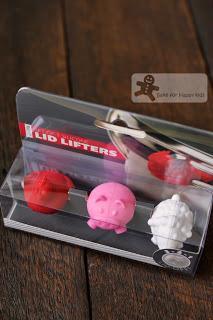
One Tovolo ice cream scoop. This giveaway is open to ALL international readers and the submission ends on 23 June 2015. Good Luck!
